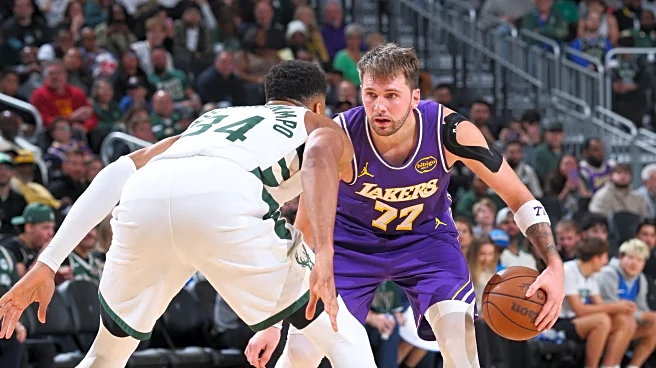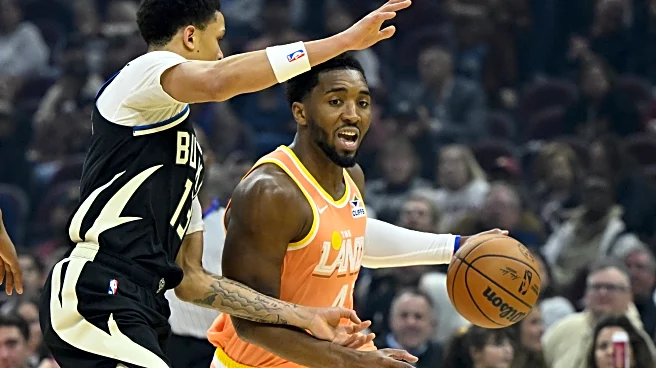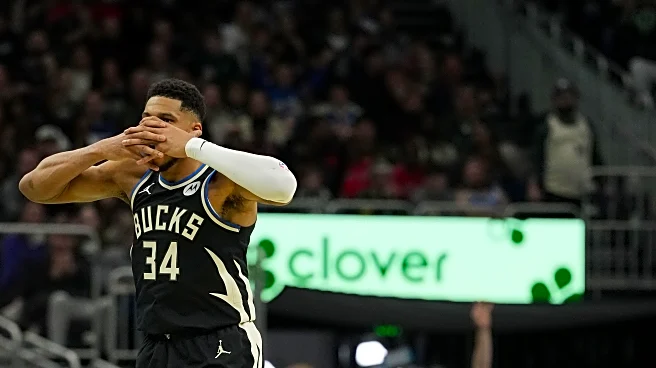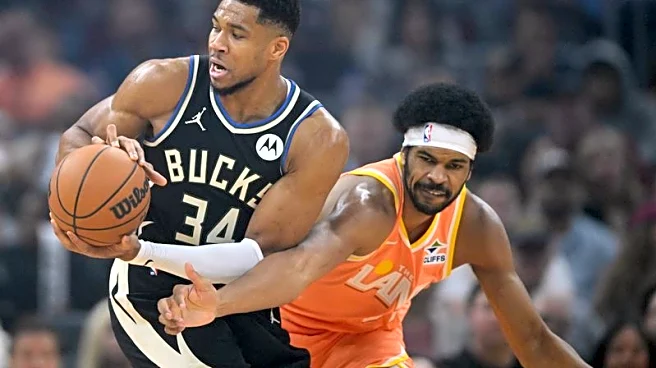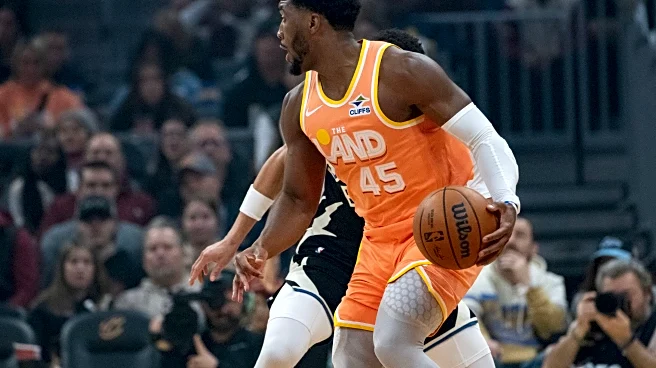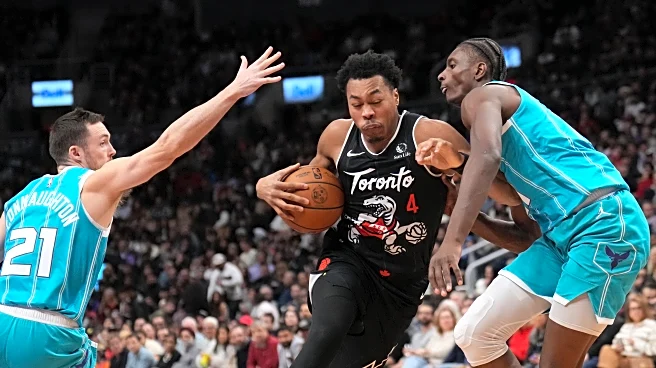The Bucks stink at defending the pick-and-roll. Any time an opponent runs the action right now, it’s basically an automatic bucket. The stats are mind-bending. Milwaukee is allowing a league-worst 64.6% roll man scoring frequency, which equates to 1.35 points per possession. For reference, the two worst transition defenses, Sacramento and Washington, are giving up 1.29 points per possession. Pick-and-roll ball handlers are scoring 41.0% of the time against the Bucks, which is 19th in the league,
but that’s hardly a silver lining when you’re already leaking points to rollers.
So, what’s the problem? What is Milwaukee doing wrong? The answer is a lot of things, but a few major trends show up in the tape from the past three games against Charlotte, Los Angeles, and Cleveland.
Blitzing blunders
In their recent matchups, the Bucks have employed the blitz as their primary P&R defense. Blitzing is when the two defenders involved in the action trap/double the ball handler right as he comes off the screen, trying to force a pass or turnover. Teams often blitz star guards who feed on pull-up jumpers and torch mismatches—guys like Luka Doncic and Donovan Mitchell, who the Bucks just faced.
Unfortunately, blitzes rarely lead to turnovers in the NBA because guys are too good. Luka, Spida, and LaMelo Ball have faced a billion doubles; they’re not just gonna panic and cough it up. So, Milwaukee is essentially opting to have all the non-stars beat them, and that’s exactly what they’re doing.
Teams have found an easy exploit to crack Bucks blitzes. Screeners are quickly slipping, getting catches in the middle of the floor, and finding themselves with massive advantages. Milwaukee’s backline defense behind the blitzes has been putrid, and it’s why they’re allowing so many points to rollers. This was a serious problem against the Lakers.
In the first clip of this compilation, Turner and Kuzma blitz Luka, and Deandre Ayton dives to the rim. AJ Green makes the elementary mistake of not tagging the roller (stepping in to take away a pass/layup), and Ayton throws down the lob after Luka predictably beats the trap. In the second clip, Green does step in to cover Ayton, but he’s way too small to prevent the score. In the third clip, Jaxson Hayes gets the ball with plenty of space in the middle of the floor, and Trent rotates over. This leaves Rollins guarding two shooters at once on the weak side—easy read for Hayes, even easier triple for Knecht.
Charlotte was also finding all the gaps in Milwaukee’s backline help. In the first clip below, Kon Knueppel gets the catch with two feet already in the paint, a death sentence for the defense. The second and third clips are the same thing for Sion James and Miles Bridges. In the fourth clip, where the Bucks are blitzing Bridges, not LaMelo, they don’t let Diabate get the ball deep in the paint, but in the act of sinking to tag him, they leave Knueppel wide open for three. In the final clip, Knueppel catches Milwaukee off guard, slipping for a pop rather than a dive. Look how dejected Trent Jr. looks as the shot goes up.
To improve the effectiveness of their blitzes, the Bucks need to start by cleaning up their rotations and not forgetting the basics, like tagging the roller. Blunders like the one AJ Green made in that first clip vs. the Lakers can’t happen against good teams (especially ones with all-time great P&R operators like Luka). That said, there are also deeper-rooted personnel issues that make things tricky. We’ll dive into those later after highlighting another way opponents are frying Milwaukee with P&Rs.
Reject regrets
A second exploit teams have found for Bucks blitzes is having the ball handler reject the screen (dribbling the opposite direction from where the screen is set; for example, going left when the screen is on the right). Because the guy defending the screener (usually Turner or Portis) comes up so high to prepare to double, there’s less resistance in place against a drive if the handler can blow by his man—and there’s been a lot of blowing-by going on. Milwaukee’s guards couldn’t stay in front of the dynamic Donovan Mitchell at all. The first clip below shows how Cleveland’s star was able to break down the defense and send everyone into rotation with a simple bursty rejection. Multiple Hornets did the same thing in Friday’s game, making Milwaukee’s perimeter defenders look like cones.
Personnel problems
Sacrificing spades of driving lanes and layups wasn’t a problem for the Bucks until recent years. The massive shift that occurred when the team fired Mike Budenholzer, traded Jrue Holiday, and lost other key defenders like Wesley Matthews and Jevon Carter is well documented. This current roster and its deployment are very different from the squads of the early 2020s. Nowadays, the Bucks just don’t have many good defensive players. AJ Green can hold his own one-on-one, but can’t get through a screen. Gary Trent Jr. gets some nice steals but is rarely able to sit in the chair and chase his man. Cole Anthony is a non-factor, if not a negative. We all know Bobby Portis’ flaws. Even Ryan Rollins, who is solid, is nowhere close to being Jrue Holiday or even a Jalen Suggs or Cason Wallace. Believe it or not, it’s tough to get stops when your players aren’t equipped to do so.
@BuckAnalytics on X developed a metric called PEST that quantifies the aggressiveness of perimeter defenders, accounting for stats such as steals, blocks, charges, and shots taken against. Rollins actually grades out in the 96th percentile league-wide in PEST—he’s a phenomenal defensive playmaker, but his on-ball results on a possession-by-possession basis don’t quite match his highlight moments. Meanwhile, Trent and Anthony rank in the 59th percentile, while AJ Green falls all the way down in the 34th. Having a barely-above-average defender as the second-best guy in your unit isn’t exactly the recipe for building a formidable fortification.
On the interior, Myles Turner has been underwhelming in certain facets too. The whole point of moving away from Brook Lopez was to open up the possibility of scheme versatility. Turner, who is younger and more athletic than Lopez, should theoretically be more apt to guard on the perimeter, but the difference between him and his predecessor has been pretty marginal in reality. He’s aggressive and comfortable in rising to the level and initiating blitzes/hedges, but if a guard attacks him, he’s probably getting cooked. His feet are slow.
Turner is best employed in drop coverage, but that’s not how Doc Rivers is using him. The big man is defending the fewest shots at the rim (per 75) of his career. It’s nice that he isn’t a total slouch in other schemes, but it’s clear that more drop is in order because the blitzes aren’t working well for anyone. The Bucks should also be actively shopping for better perimeter stoppers on the trade market, because without an upgrade in that department, they won’t be able to execute any coverage smoothly.
The Bucks aren’t modeled to be a defensive juggernaut anymore, and that’s fine, especially because their offensive rating of 128 with Giannis on the floor would rank number one in the association. However, they’re not going to achieve any meaningful success without cleaning up their pick-and-roll defense, which will require some drastic revisions to their schemes and roster.
